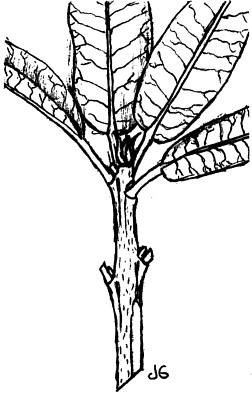QBARS - v30n3 The Truth About Rootability of Cuttings
The Truth About Rootability of Cuttings
By G. G. Nearing, Ramsey, New Jersey
A Reprint from Vol. 13 No. 2, ARS Bulletin April 1959

|
Requested by Bryon Vermul, who wrote "I am personally inclined to think that Mr. Nearing is correct, however reprinting this article might prompt a modern researcher or two to reply with new findings."
Recent scientific findings that cuttings taken from young plants root more easily than those from old plants, are based on several misinterpretations of the facts, and if followed, will result in losses to propagators or in much harm to the cause of Rhododendrons. Cuttings from old plants, if those plants have been properly handled, root just as readily as cuttings from young plants, usually even better. Taking cutting from young plants only, will inevitably result in degeneration of the entire hybrid clone.
It would be convenient for propagators if they could take their cuttings from plants newly propagated, and not need to maintain a number of otherwise useless older stock plants for cutting production, but after a dozen or so generations of a cutting from a cutting from a cutting, degeneration and loss of vigor set in. The leaves become smaller and smaller, the new growths slenderer and poorer. Many plants now offered in the trade already show this tendency, and no doubt it will soon be named as a new disease by scientists who refuse to recognize its cause.
At first the loss of vigor lasts only a year or two, but the greater the number of generations that a plant is removed from the original clone plant, the longer will the deficiency in vigor persist. Eventually, as nurserymen have known for a century, a clone so handled will run out, the propagations refusing to develop into saleable plants. The number of generations required to ruin a clone cannot be stated exactly, as it is different for each clone.
The way to maintain a varietal clone in healthy condition is to select stock plants that are removed as few generations as possible from the original clone, and to take cuttings only from them, maintaining these stock plants always under the most favorable conditions. Another generation or two would usually do no perceptible harm, but the habit of doing the wrong thing is so easily acquired that anyone stretching to a few more cutting generations is sure to continue until the clone runs out.
But the plants set aside for stock must be cut with great restraint. If more than one-third of the tips are cut in any one season, the plants will lose vigor, so that cutting taken from them the following season will not root well. If cut severely for several years, the stock plants will collapse entirely. Even when cutting is limited to one-third of the tips, the plants should be given a complete rest about every third year.
This rule applies only to plants on their own roots. Grafts must be treated even more cautiously. After four or five years, the graft union usually deteriorates, causing a loss of vigor, and a progressive lessening of the ability of cuttings from that plant to root. If the understock has been destroyed by deep planting, the grafted plant will then, after a few years, give the same response as a cutting or a layer. But deep planting to destroy the understock, though often talked about, is seldom practiced, since it entails a loss of about two years' growth before the new root ball higher on the stalk develops sufficient size to support the plant.
Apparently, though I am not sure of this, a plant which has lost some vigor as a result of too many generations removal from the original clone, will regain part of that vigor as it ages, and will then yield cuttings more rootable than those taken from it in its younger stages. As I have pointed out elsewhere, a cutting grown Rhododendron two years old has less vigor than a graft of the same age. At about four years, the graft and cutting are usually more or less equal in vigor. The cutting requires a couple of years to break down the cellular structure at ground level, rebuild with a new cellular system, and convert this section into a proper crown for efficient handling of the interchange of crude and elaborated sap. If not forced with chemicals, it will have completed this conversion by about the third year, and will increase in vigor, overtaking and passing the grafted plant. The graft, on the contrary, will begin to suffer after the third or fourth year, from cellular incompatibility at the graft union, which is progressive, and the plant usually loses vigor from that point on. If the understock has been destroyed by deep planting, the graft will progress about equally with the rooted cutting, but a year or so behind it in total growth.
No doubt the scientific findings that young plants produce more readily rootable cuttings than old ones, which is exactly contrary to the truth, were based on older plants which had been grown from grafts, or had been cut too heavily for several successive seasons, or had been ruined by chemicals, or a combination of all three evils. The study should be made over again, if its authors will just swallow their pride, and stock plants that have been properly handled for their entire lifetime, if any such can be found, should be substituted for the defective ones used in the original experiment.
